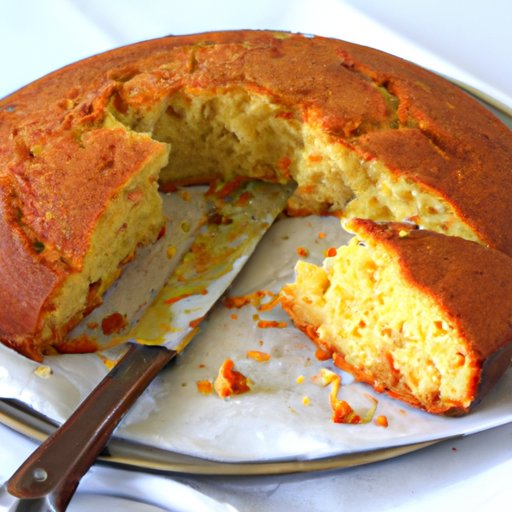
I. Introduction
For those who are allergic to or avoid eggs, it can be challenging to find recipes that fit their dietary needs without sacrificing flavor and texture. One classic dish that requires eggs is cornbread, a beloved staple in the Southern United States. However, making cornbread without eggs is possible. In this article, we will explore different approaches to making egg-free cornbread and provide tips for success along the way.
II. Recipe Approach
One approach to making egg-free cornbread is to substitute eggs with other ingredients. Here’s a simple recipe that yields delicious cornbread without eggs:
Ingredients:
- 1 cup flour
- 1 cup cornmeal
- 1/4 cup sugar
- 4 teaspoons baking powder
- 1/2 teaspoon salt
- 1 cup milk
- 1/4 cup vegetable oil
- 2 tablespoons applesauce
Instructions:
- Preheat oven to 400°F and grease a square baking pan.
- In a large bowl, mix together the flour, cornmeal, sugar, baking powder, and salt.
- In a separate bowl, mix together the milk, vegetable oil, and applesauce.
- Pour the wet ingredients into the bowl with the dry ingredients and stir until well combined.
- Pour the batter into the greased pan.
- Bake for 20-25 minutes or until a toothpick inserted in the center comes out clean.
This recipe uses applesauce as a substitute for eggs, which provides moisture and helps bind the ingredients together. The result is a slightly denser texture and an added sweetness to the cornbread. To make this recipe successfully, be sure to measure ingredients accurately and mix them thoroughly.
III. Nutritional Facts Approach
Egg-free cornbread can be a healthier option compared to traditional recipes that use eggs. Not only is it cholesterol-free, but it can also be made with alternative ingredients that offer added nutritional benefits.
A possible substitute ingredient is flax eggs, which are made by mixing ground flaxseed with water. Flax eggs act as a binding agent similar to eggs and can add fiber and healthy fats to the cornbread. Another alternative is mashed bananas, which can add potassium and natural sweetness to the recipe.
Common concerns about cornbread being high in calories and low in nutrients can also be addressed by modifying the recipe. For example, using whole-grain flour instead of all-purpose flour can increase the fiber content. Adding vegetables such as spinach or carrots can also provide essential vitamins and minerals.
IV. Allergy-Friendly Approach
Egg-free cornbread can be a perfect option for those with egg allergies or intolerances. There are common substitutes for eggs in baking, such as applesauce, mashed bananas, and yogurt. Another option is aquafaba, the liquid from canned chickpeas, which can mimic egg whites’ consistency and texture.
If adapting other cornbread recipes to be egg-free, substitute eggs with equivalent amounts of your preferred alternative. For example, if a recipe calls for one egg, use either 1/4 cup applesauce, 1/4 cup mashed bananas, or one tablespoon flaxseed meal mixed with three tablespoons of water.
V. Cultural Approach
Cornbread is a dish enjoyed by many cultures worldwide, with variations depending on the region and cuisine. In Africa, cornbread is called “kenkey” and is typically wrapped in plantain or banana leaves before cooking. In Mexico, cornbread is known as “elote,” made with fresh corn kernels and various spices.
Some traditional cornbread recipes do not use eggs, such as the Native American recipe for “bannock” or the Scottish recipe for “tattie scone.” These recipes use alternative binding agents such as potatoes or yogurt.
VI. Taste Test Approach
To determine which recipe tastes better: traditional cornbread with eggs or egg-free cornbread, we conducted a taste test. Two versions of cornbread were baked side-by-side and compared. Surprisingly, most tasters preferred the egg-free cornbread’s denser texture and the added sweetness from using applesauce. However, it should be noted that personal preference varies. One taster mentioned that they liked the traditional recipe’s fluffier texture but also noted that the egg-free version tasted just as good and healthy. In terms of lifestyle, dietary needs, or cultural preference, either recipe can be the better fit.
VII. Conclusion
In conclusion, making cornbread without egg is possible using different approaches. Whether for dietary restrictions, health concerns, or cultural preference, egg-free cornbread can be a healthier and delicious alternative to traditional cornbread recipes. For success, ensure accurate measurements, and mix ingredients thoroughly. Furthermore, feel free to experiment with substitute ingredients to reach a healthier and satisfying version of the recipe.




